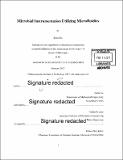Microbial instrumentation utilizing microfluidics
Author(s)
Ge, Zhifei, Ph. D. Massachusetts Institute of Technology
DownloadFull printable version (15.90Mb)
Other Contributors
Massachusetts Institute of Technology. Department of Mechanical Engineering.
Advisor
Cullen R. Buie.
Terms of use
Metadata
Show full item recordAbstract
Reconstruction of phylogenetic trees based on 16S rRNA gene sequencing reveals abundant microbial diversity in nature. However, studies of microbiology have been limited by the capabilities to replicate the natural environment or artificially manipulate cells. Advances in microbial instrumentation with microfluidics can break through these challenges. In nature, bacteria live in communities with abundant inter-species chemical communication. To replicate such environments in laboratory conditions, nanoporous microscale microfluidic incubators (NMMIs) for co-culture of multiple species have been developed. The NMMIs enable high-throughput screening and real-time observation of multiple species co-cultured simultaneously. The key innovation in the NMMIs is that they facilitate inter-species communication while maintaining physical isolation between species. NMMIs are a useful tool for the discovery of previously uncultivated organisms and for the study of inter-species microbial interactions. The land and seas are teeming with microbes but one region of the environment often neglected is the air. Large numbers of microbes are present in air yet little is known about the mechanisms that lead to their dispersion. We have elucidated one such dispersion mechanisms involving rain and soil bacteria. The experimental system replicates the process of raindrops impinging on soil surfaces that contain bacteria. It is demonstrated that up to 0.01% of soil bacteria can be dispersed by aerosolization and survive for more than an hour after the aerosolization process. This mechanism can be relevant for the investigation of climate change, pathogenic disease transmission, and geographic migration of bacteria. In spite of the challenges outlined above there are thousands of known species of bacteria that have been catalogued and genetically sequenced. However, few of these organisms are amenable to modem genetic manipulation tools. Thus there is a great benefit for a tool that accelerates the development of efficient genetic transformation protocols. We have developed a microfluidic electroporation device to address this challenge. The key novelty is the microchannel geometry which applies a linear electric field gradient to each sample. This design enables rapid determination of the electric field that leads to quantifiable bacterial electroporation. Bacterial strains with both industrial and medical relevance have been successfully characterized using this assay.
Description
Thesis: Ph. D., Massachusetts Institute of Technology, Department of Mechanical Engineering, 2017. Cataloged from PDF version of thesis. Includes bibliographical references (pages 126-150).
Date issued
2017Department
Massachusetts Institute of Technology. Department of Mechanical EngineeringPublisher
Massachusetts Institute of Technology
Keywords
Mechanical Engineering.